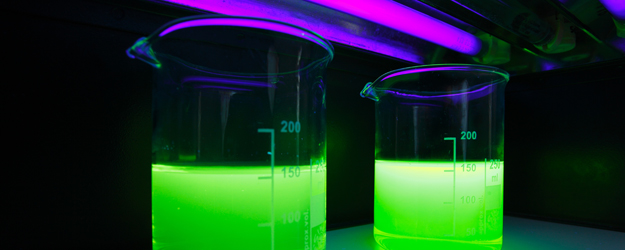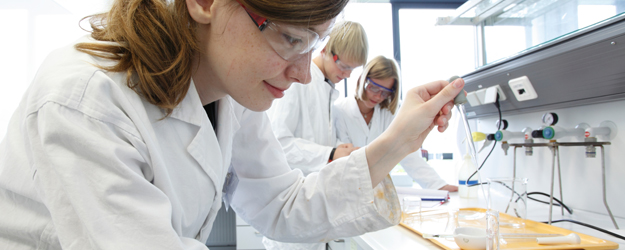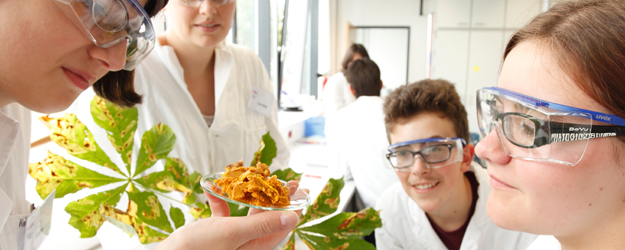16 August 2012
The NaT-Lab school laboratory at Johannes Gutenberg University Mainz (JGU) has moved to its latest home in the Institute of Physical Chemistry's new building – just in time to undergo its first major field trial: For four days, pupils will be using it to track down dyes. By performing a range of experiments, they will gain completely different insights into chemistry, biology, and physics than they would during normal lessons.
A dark broth bubbles away in a flask. It doesn't actually look very exciting, but Jonas is absolutely riveted. The white lab coat hangs loosely on the 18-year-old's slim frame as he examines the concoction distilled from chestnut tree branches through his safety glasses.
"Now we'll put it under UV light," says Carolin Heeschen, a doctoral candidate in chemistry. Jonas places the glass under the box-shaped lamp. "Look, it's turning green," he says happily. Heeschen furrows her brow. "It's actually supposed to be blue," she says uncertainly. All of a sudden it is – the liquid under the ultraviolet light glows a strong blue. "Cool," comments Jonas.
A squeaky clean permanent home
This native of Mainz is one of 18 pupils who are inaugurating the new rooms of the NaT-Lab in Duesbergweg during the "Colors" Summer Academy. Everything is still spic and span and the room with its six lab benches even smells new, but the young students will change that over the next four days. They have a big program ahead of them: They are supposed to be conducting intensive research from 9:00 in the morning until 5:00 in the afternoon. During the lunch break, they can mingle with the university students in the canteen and take in a bit of the campus air.
"We have finally found a permanent home in the new chemistry building," states Dr. Christa Welschof with a smile. However, at the same time, the head of the NaT-Lab adds: "There is not as much room here as we had in the Welderweg." But the numerous course participants in the past always said how ugly the rooms in the old slab-block building were. "I didn't really notice it anymore," she explains. "Of course, it's also an important factor: After all, it's our aim to encourage people to study here."
6,000 high school children encouraged to experiment
It was because of a remarkably low number of applications to study chemistry that the NaT-Lab was first established in 2000. "It began on a very small scale," says Welschof. "It didn't even have its own rooms. Then the project began to grow and grow. Now, more than 6,000 school children come every year to the lab while more than 10,000 get involved in natural science projects."
The NaT-Lab's existence has always been precarious. "Financing was always uncertain. Then two years ago, Professor Hofmeister, Dean of the Faculty of Chemistry, decided that this was something we needed." He then set everything in motion. "Today we have a budget even though we still have to raise third-party funds." The Robert Bosch Foundation, for example, donated the basic equipment for the NaT-Lab and the chemicals industry covers most of the costs of the Summer Academy. The pupils only pay EUR 50 for the four days, including room and board.
More exciting than school
Jan actually lives in London, but the opportunity to gain practical experience in the NaT-Lab persuaded the 18-year-old to come to Mainz. "Most chemistry courses are three-fourths theoretical. It is completely different here. We are constantly experimenting. It is much more exciting than school," he says seriously, "and it is much more relaxed."
Experimentation and an easygoing approach to chemistry, biology, physics and geology are also important in Welschof's eyes. "There is far too little of it in schools today," she claims, voicing criticism. "We can also work with smaller groups in the NaT-Lab." Doctoral candidates help out and teaching degree students have the opportunity to experience close contact with pupils. "They can do their teaching practice with us, instead of having to go out to a school."
Close contact with students
Heeschen is responsible for a three-man team in the Summer Academy. "I had never thought that they would ask so many questions," she says. "They even want to know everything about studying at university. They are genuinely interested in what is going on. It's a lot of fun."
"When I am teaching in the NaT-Lab there is more of a teacher-student relationship," explains Welschof. "The contact is much closer with our students." And this is one of the objectives of the NaT-Lab.
School classes constitute the majority of visitors to the laboratory of Welschof and her colleagues. "We get a new one every day." School children from fifth grade onwards get to spend a morning in the lab. There is also the Green School in the Botanic Garden, while future researchers can also visit the Institutes of Nuclear Physics, Geology, or Biophysics. We want to make it apparent that no discipline is an island, everything is connected." This can be made clear most readily in the Summer Academy with its very inquisitive pupils.
Girls in the majority
Thuy My attends Mainz's Schlossgymnasium school. The 18-year-old is fascinated by the way that the group taking part in the academy is made up: "I never imagined that there would be so many girls." At school, My is more of an exception. Her advanced chemistry course is two-thirds male. But in the NaT-Lab, girls are in the majority. "I have been doing this for eight years and things have actually changed a lot," comments Welschof. "Girls now really don't care that chemistry used to be a subject for boys."
So there is Anna beside Jonas and Jennifer next to Jan, all focusing on the experiment to produce indigo blue from chestnut tree branches. What they manage to produce seems to be an unattractive mess with a color ranging between green, yellow, and dirty brown. The blue will only appear during the dyeing process. "Did you know that the German idiom 'blau machen' (to 'make blue' or skip work) comes from the dyeing industry?" asks Welschof in an aside: While the dyed material was hung up to dry, the dyer could take a break.
Suddenly a small fountain appears and splashes the ceiling of the new lab. "This should not be happening," says Heeschen amazed. "It can't explode. Maybe there was something wrong with the sodium hydroxide solution?" Nevertheless, the NaT-Lab has now been well and truly baptized. "Cool" whispers Jonas, while Welschof goes off to get something to clean up with. "That has never happened before," she grumbles.



